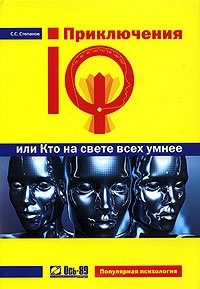Читать книгу - "Коннектом. Как мозг делает нас тем, что мы есть - Себастьян Сеунг"
Аннотация к книге "Коннектом. Как мозг делает нас тем, что мы есть - Себастьян Сеунг", которую можно читать онлайн бесплатно без регистрации
176. Kim, I. J., Y. Zhang, M. Yamagata, M. Meister, and J. R. Sanes. 2008. Molecular identification of a retinal cell type that res ponds to upward motion. Nature, 452 (7186): 478–482.
177. Knott, G., H. Marchman, D. Wall, and B. Lich. 2008. Serial section scanning electron microscopy of adult brain tissue using focu sed ion beam milling. Journal of Neuroscience, 28 (12): 2959.
178. Knudsen, E. I., and P. F. Knudsen. 1990. Sensitive and critical periods for visual calibration of sound localization by barn owls. Journal of Neuroscience, 10 (1): 222.
179. Kola, I., and J. Landis. 2004. Can the pharmaceutical industry reduce attrition rates? Nature Reviews Drug Discovery, 3 (8): 711–716.
180. Kolb, B., and R. Gibb. 2007. Brain plasticity and recovery from early cortical injury. Developmental Psychobiology, 49 (2): 107–118.
181. Kolodkin, A. L., and M. Tessier-Lavigne. 2011. Mechanisms and molecules of neuronal wiring: A primer. Cold Spring Har bor Perspectives in Biology, 3: a001727.
182. Kolodzey, J. 1981. Cray-computer technology. IEEE Transactions on Components, Hybrids, and Manufacturing Technology, 4 (2): 181–186.
183. Kornack, D. R., and P. Rakic. 1999. Continuation of neurogenesis in the hippocampus of the adult macaque monkey. Procee dings of the National Academy of Sciences, 96 (10): 5768.
184. Kornack, D. R., and P. Rakic. 2001. Cell proliferation without neurogenesis in adult primate neocortex. Science, 294 (5549): 2127.
185. Kostovic, I., and P. Rakic. 1980. Cytology and time of origin of interstitial neurons in the white matter in infant and adult human and monkey telencephalon. Journal of Neurocytology, 9 (2): 219.
186. Kozel, F. A., K. A. Johnson, Q. Mu, E. L. Grenesko, S. J. Laken, and M. S. George. 2005. Detecting deception using functional mag netic resonance imaging. Biological Psychiatry, 58 (8): 605–613.
187. Kubicki, M., H. Park, C. F. Westin, P. G. Nestor, R. V. Mulkern, S. E. Maier, M. Niznikiewicz, E. E. Connor, J. J. Levitt, M. Frumin, et al. 2005. DTI and MTR abnormalities in schizophrenia: Analysis of white matter integrity. Neuroimage, 26 (4): 1109–1118.
188. Kullmann, D. M. 2010. Neurological channelopathies. Annual Review of Neuroscience, 33: 151–172.
189. Lander, E. S. 2011. Initial impact of the sequencing of the human genome. Nature, 470 (7333): 187–197.
190. Langleben, D. D., L. Schroeder, J. A. Maldjian, R. C. Gur, S. McDonald, J. D. Ragland, C. P. O’Brien, and A. R. Childress. 2002. Brain activity during simulated deception: An eventrelated functional magnetic resonance study. Neuroimage, 15 (3): 727–732.
191. Lashley, K. S. 1929. Brain mechanisms and intelligence: A quantitative study of injuries to the brain. Chicago: University of Chicago Press.
192. Lashley, K. S., and G. Clark. 1946. The cytoarchitecture of the cerebral cortex of Ateles: A critical examination of architectonic studies. Journal of Comparative Neurology, 85 (2): 223–305.
193. Lassek, A. M., and G. L. Rasmussen. 1940. A comparative fiber and numerical analysis of the pyramidal tract. Journal of Comparative Neurology, 72 (2): 417–428.
194. Laureys, S. 2005. Death, unconsciousness, and the brain. Nature Reviews Neuroscience, 6 (11): 899–909.
195. Lederberg, J., and A. T. McCray. 2001. ’Ome sweet ’omics:
A genealogical treasury of words. Scientist, 15 (7): 8.
196. Leeuwenhoek, A. van. 1674. More Observations from Mr. Leewen hook, in a Letter of Sept. 7. 1674. Sent to the publisher. Philosophical Transactions, 9 (108): 178–182.
197. Legrand, N., A. Ploss, R. Balling, P. D. Becker, C. Borsotti, N. Brezillon, and J. Debarry. 2009. Humanized mice for modeling human infectious disease: Challenges, progress, and outlook. Cell Host and Microbe, 6 (1): 5–9.
198. Leroi, A. 2006. What makes us human? Telegraph, Aug. 1.
199. Leucht, S., C. Corves, D. Arbter, R. R. Engel, C. Li, and J. M. Davis. 2009. Second-generation versus first-generation antipsychotic drugs for schizophrenia: A meta-analysis. Lan cet, 373 (9657): 31–41.
200. Lewis, D. A., and P. Levitt. 2002. Schizophrenia as a disorder of neurodevelopment. Annual Review of Neuroscience, 25: 409.
201. Lichtman, J. W., and H. Colman. 2000. Synapse elimination review and indelible memory. Neuron, 25: 269–278.
202. Lichtman, J. W., J. R. Sanes, and J. Livet. A technicolour approach to the connectome. Nature Reviews Neuroscience, 9 (6): 417–422.
203. Lieberman, P. 2002. On the nature and evolution of the neural bases of human lan guage. American Journal of Physical Anthropology, 119 (S35): 36–62.
204. Lindbeck, A. 1995. The prize in economic science in memory of Alfred Nobel. Journal of Economic Literature, 23 (1): 37–56.
205. Linkenhoker, B. A., and E. I. Knudsen. 2002. Incremental training increases the plasticity of the auditory space map in adult barn owls. Nature, 419 (6904): 293–296.
206. Lipton, P. 1999. Ischemic cell death in brain neurons. Physiological Reviews, 79 (4): 1431–1568.
207. Livet, J., T. A. Weissman, H. Kang, J. Lu, R. A. Bennis, J. R. Sanes, and J. W. Lichtman. 2007. Transgenic strategies for combinatorial expression of fluorescent proteins in the nervous system. Nature, 450 (7166): 56–62.
208. Lledo, P. M., M. Alonso, and M. S. Grubb. 2006. Adult neurogenesis and functional plasticity in neuronal circuits. Nature Reviews Neuroscience, 7 (3): 179–193.
209. Llinas, R., Y. Yarom, and M. Sugimori. 1981. Isolated mamm al ian brain in vitro: New technique for analysis of electrical activity of neuronal circuit function. Federation Proceedings, 40: 2240.
210. Lloyd, Seth. 2006. Programming the universe: A quantum computer scientist takes on the cosmos. New York: Knopf.
211. Lockery, S. R., and M. B. Goodman. 2009. The quest for act ion potentials in C. elegans neurons hits a plateau. Nature Neuroscience, 12 (4): 377–378.
212. Lopez-Munoz, F., and C. Alamo. 2009. Monoaminergic neurotransmission: The history of the discovery of antidep res sants from 1950s until today. Current Pharmaceutical Design, 15 (14): 1563–1586.
213. Lotze, M., H. Flor, W. Grodd, W. Larbig, and N. Birbaumer. 2001. Phantom movements and pain: An fMRI study in upper limb amputees. Brain, 124 (11): 2268.
214. Machin, Geoffrey. 2009. Non-identical monozygotic twins, inter mediate twin types, zygosity testing, and the non-random natur e of monozygotic twinning: A review. American Journal of Medical Genetics, C, Seminars in Medical Genetics, 151C (2): 110–127.
Прочитали книгу? Предлагаем вам поделится своим впечатлением! Ваш отзыв будет полезен читателям, которые еще только собираются познакомиться с произведением.
Оставить комментарий
-
 Вера Попова27 октябрь 01:40
Любовь у всех своя-разная,но всегда это слово ассоциируется с радостью,нежностью и счастьем!!! Всем добра!Автору СПАСИБО за добрую историю!
Любовь приходит в сентябре - Ника Крылатая
Вера Попова27 октябрь 01:40
Любовь у всех своя-разная,но всегда это слово ассоциируется с радостью,нежностью и счастьем!!! Всем добра!Автору СПАСИБО за добрую историю!
Любовь приходит в сентябре - Ника Крылатая
-
 Вера Попова10 октябрь 15:04
Захватывает,понравилось, позитивно, рекомендую!Спасибо автору за хорошую историю!
Подарочек - Салма Кальк
Вера Попова10 октябрь 15:04
Захватывает,понравилось, позитивно, рекомендую!Спасибо автору за хорошую историю!
Подарочек - Салма Кальк
-
 Лиза04 октябрь 09:48
Роман просто супер давайте продолжение пожалуйста прочитаю обязательно Плакала я только когда Полина искала собаку Димы барса ♥️ Пожалуйста умаляю давайте еще !))
По осколкам твоего сердца - Анна Джейн
Лиза04 октябрь 09:48
Роман просто супер давайте продолжение пожалуйста прочитаю обязательно Плакала я только когда Полина искала собаку Димы барса ♥️ Пожалуйста умаляю давайте еще !))
По осколкам твоего сердца - Анна Джейн
-
 yokoo18 сентябрь 09:09
это прекрасный дарк роман!^^ очень нравится
#НенавистьЛюбовь. Книга вторая - Анна Джейн
yokoo18 сентябрь 09:09
это прекрасный дарк роман!^^ очень нравится
#НенавистьЛюбовь. Книга вторая - Анна Джейн





